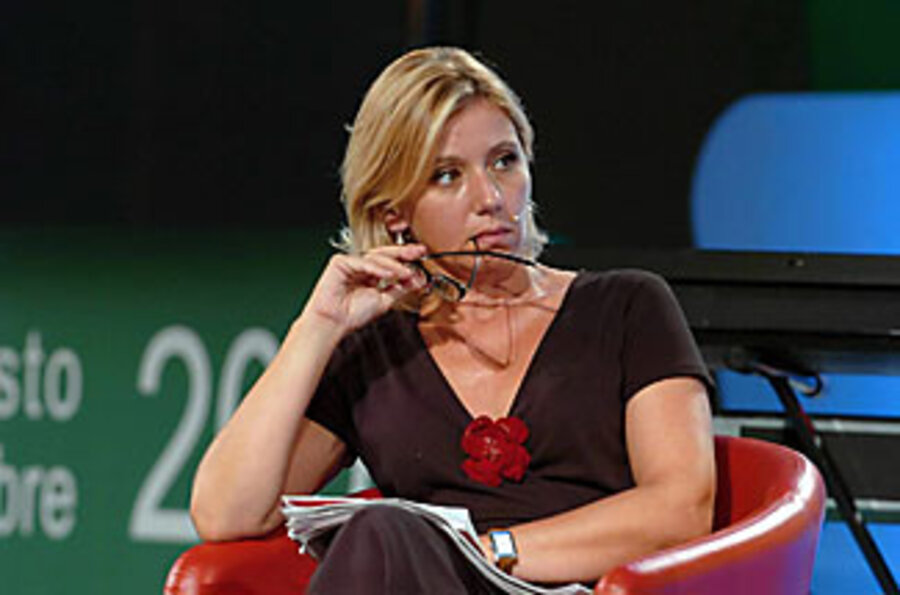In Italy, female editor signals women's rise
| Milan, Italy
When Concita de Gregorio became the editor in chief of L'Unità, a national newspaper, she said she wanted to focus on politics and daily news: "We have had enough commentary, now we need facts," she wrote in her first editorial on Aug. 26.
Ms. Gregorio's appointment and business-like attitude came as a surprise to many Italians, who are not used to seeing a woman in such a powerful position. Founded in 1924 by communist philosopher Antonio Gramsci and now associated with the Democratic Party, L'Unità is one of Italy's most prestigious newspapers.
Sexist critics challenged her appointment as likely to undermine the publication's reputation. "I bet now we'll see many easy recipes for working mothers and advice [in the paper] on how to behave like prostitutes when [their] husbands come home," wrote Paolo Guzzanti, a conservative columnist and lawmaker, in the right-leaning paper Il Giornale.
Italy ranks second-lowest among Western European countries, followed by Portugal, in women's rights and social status issues, according to the human rights organization Save the Children's 'mother' index, which evaluates the worldwide condition of women and children based on income, political participation, and health. In this context, Gregorio's new position is seen to signal a cultural shift.
"I was quite surprised. [Gregorio's hire] is really a sign that times are changing and Italy is getting closer to American and Western European standards," says Anna Mazzone, the editor of Formiche, a news monthly magazine.
"In Italy, we have had the perception that a political paper is not supposed to cover women's right or social issues," adds a female journalist at L'Unità, who wishes not to be identified.
Women readers of the newspaper are as excited as some L'Unità employees by the appointment. "I am as happy as a child to see a woman finally running the paper," says Maria Anna Sabelli, a doctor in Milan who has been reading L'Unità for 30 years.
Gregorio herself, who was not available for comment, tends to downplay the novelty. "It's not as if I'll produce a 'pink' newspaper and that's it," she said last month in an interview with Radio 24.
Italian women in the newsroom
Gregorio's editorship is part of a wider trend of Italian women succeeding in the national media. In 2000, Flavia Perina became the first female editor of the far-right daily Il Secolo d'Italia, and in 2002, Daniela Hamaui became the first woman to head L'Espresso, an investigative news magazine.
"Journalism is the one field where we will soon reach gender equality," says Franco Abruzzo, a professor at the Carlo de Martino Institute for Education in Journalism in Milan.
He adds that 45 percent of professional journalists in Milan are women and that the percentage is expected to grow as 50 percent of young apprentices are female. "My female students are studying the most and working harder," he says.
Italy's track record for female employment in the media resembles that of other European countries. In Britain, Rosie Boycott was appointed editor of The Independent in 1998. Currently, two major British papers, The Sun and Daily Star, are headed by women. And while none of the major newspapers in Spain have female editors in chief, El Mundo and El Paìs have female deputy editors.
Victims of cronyism
But other indicators of gender equity in the workplace are mixed. Until recently, Italy scored low on women's participation in politics. But the parliament doubled its percentage of female lawmakers in six years, from 9.8 percent in 2002 to 21.1 percent today. This is in line with the Western European average and was facilitated by the conservative government in 2004, which introduced mandatory quotas for women in the electoral lists.
Still, overall female employment remains low compared to elsewhere in Europe. Only 45.1 percent of Italian women work outside their home, according to figures released in 2006 by Eurispes, a nonprofit research organization. This is in contrast with Spain and France, where the average is above 50 percent, and Denmark and Sweden, where over 70 percent of women are employed. Only 2 percent of executive positions are held by women in Italian companies, according to a study published in May by La Repubblica newspaper.
Ms. Mazzone believes the lack of women in the workforce has less to do with culture than the Italian economic system, which is rife with corruption and cronyism. About 40 percent of Italian workers say they got their job through nepotism or connections, according to a 2007 poll. Mazzone suggests that women are penalized by a system that overlooks merit, as 98 percent of executives are men. "Here people don't care how hard you work," she argues. "[If] you hire and promote people because they are your buddies, of course you choose the boys."
• Lisa Abend contributed from Spain.





